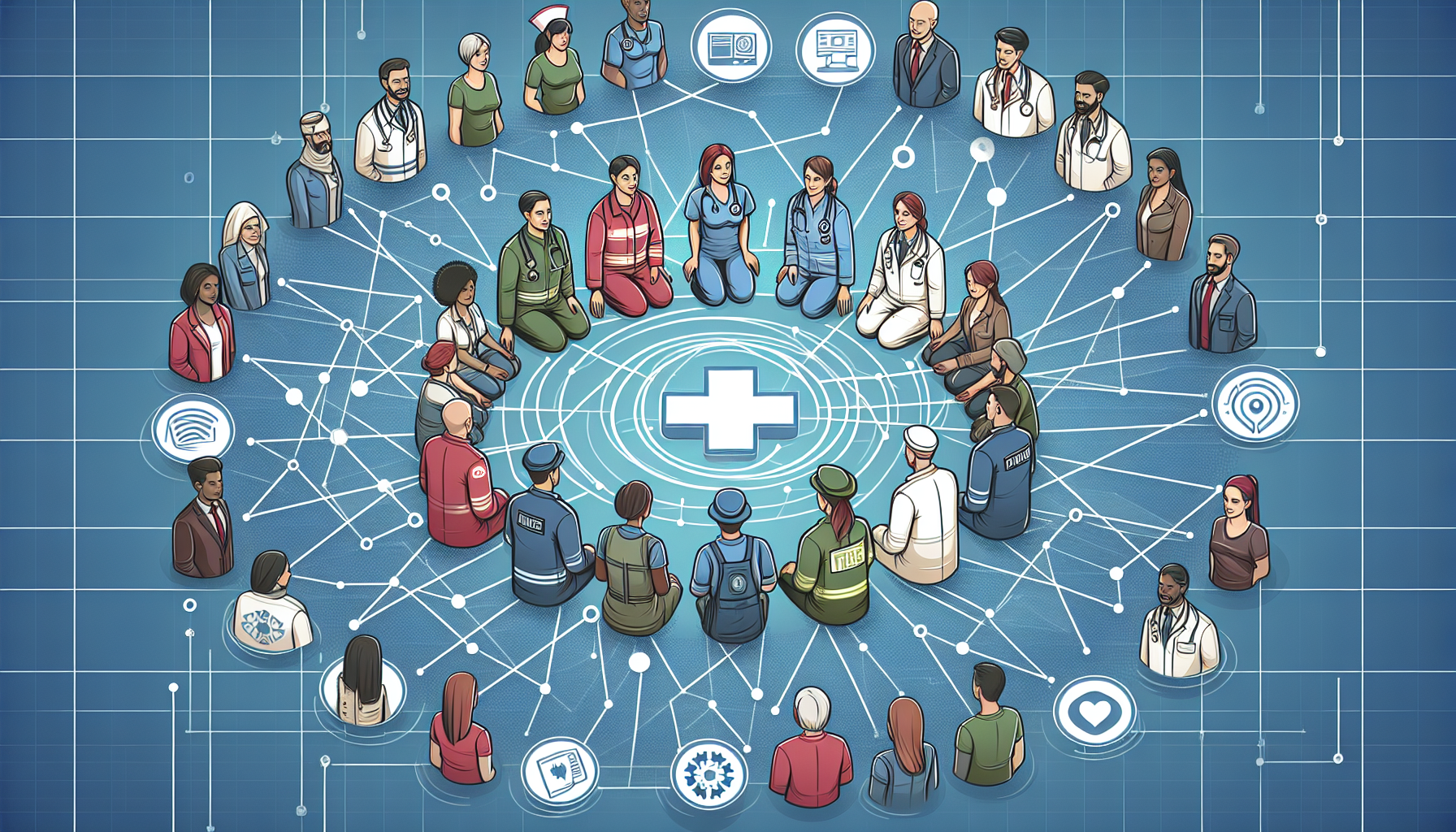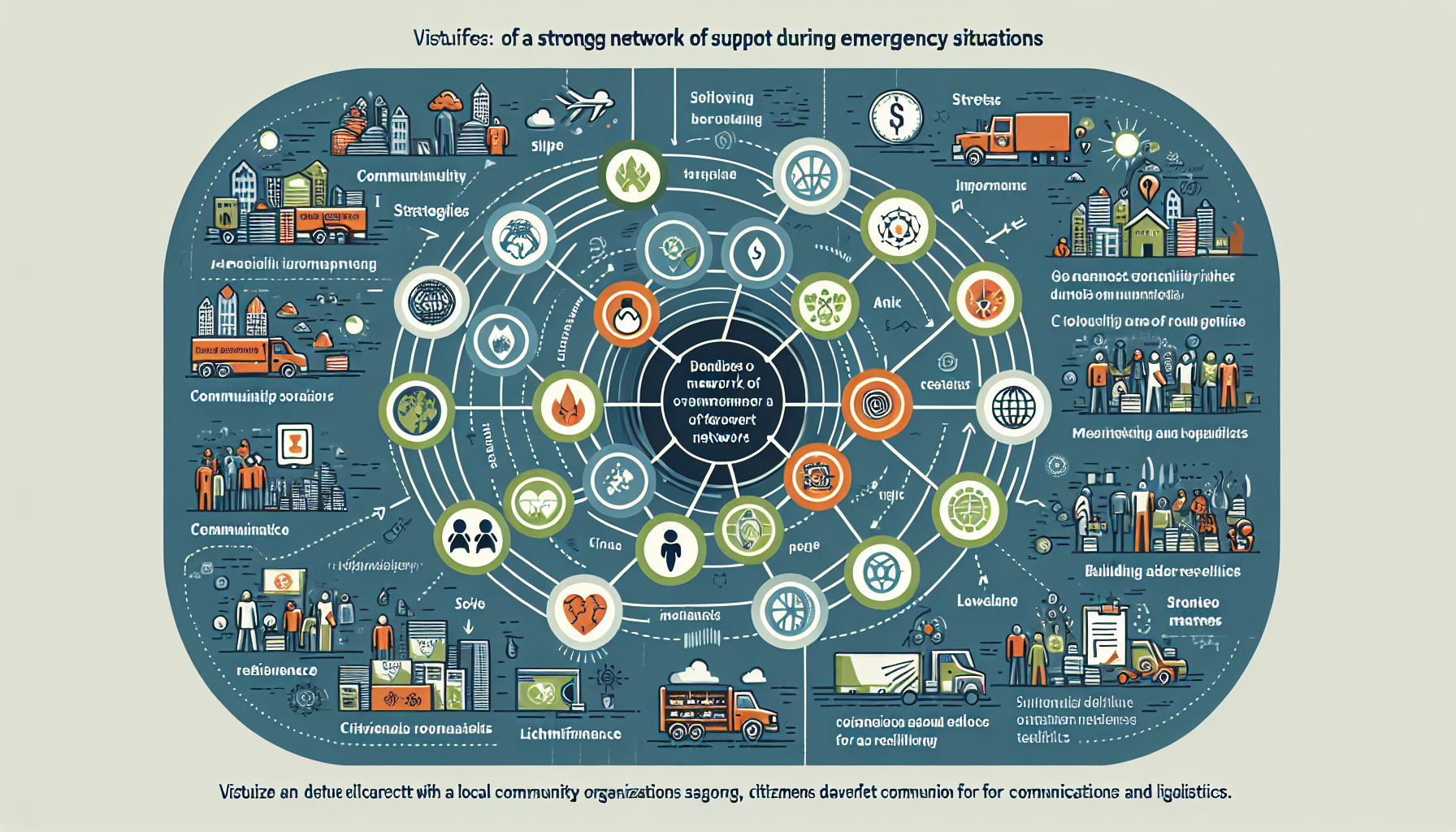In a world where unexpected emergencies can arise at any moment, it is crucial to have a strong network of support to rely on. But how can you ensure that you have a group of people ready to assist you in times of urgent need? Creating a network of support for emergency situations may seem like a daunting task, but fear not! This article will provide you with practical tips and strategies on how to build a supportive network that can come to your aid when it matters most. So, let’s dive in and learn how to create a network of support for those dire moments.
Identifying Potential Network Members
Identify friends, family, and neighbors
When creating a network of support for emergency situations, it is crucial to start by identifying the people who are closest to you. Friends, family, and neighbors can be your first line of defense during a crisis. These are the individuals who are likely to be there for you when you need them the most. Reach out to them and begin building a strong foundation for your network.
Find local emergency response organizations
In addition to your personal connections, it is essential to reach out to local emergency response organizations. These organizations are dedicated to providing assistance during emergencies and can offer valuable resources and expertise. Research and contact organizations such as the Red Cross, local fire departments, and community emergency management agencies. Collaborating with these organizations can greatly enhance your network’s ability to respond effectively during crisis situations.
Reach out to community groups and associations
Community groups and associations are another excellent source for potential network members. These groups are often rooted in the neighborhood and can provide a sense of community and support during emergencies. Local sports clubs, religious organizations, and volunteer groups are just a few examples of these community networks. By connecting with them, you can strengthen your network and tap into a wide range of skills and resources.
Consider professionals in relevant fields
When building a network for emergency situations, it can also be beneficial to consider professionals in relevant fields. Doctors, nurses, electricians, plumbers, and other professionals can bring valuable skills and knowledge to the table. These individuals can offer guidance, expertise, and resources that can be crucial during emergency situations. Reach out to professionals in your community and invite them to join your network.
Connect with online communities
In today’s digital age, online communities can be an invaluable resource for creating a network of support. Utilize social media platforms and online forums to connect with like-minded individuals who are interested in emergency preparedness. These communities often share information, resources, and experiences that can enrich your knowledge and expand your network. Engaging with online communities can also provide a wider reach and access to different perspectives and expertise.
Establishing Communication Channels
Utilize phone calls and text messages
In times of emergency, reliable communication channels are vital for coordination and support. Utilize traditional means of communication, such as phone calls and text messages, to stay in touch with network members. These methods are widely accessible and can ensure quick and direct communication when needed. Exchange contact information with your network members and establish the importance of prompt communication during emergencies.
Create a group chat or messaging platform
To enhance communication within your network, consider creating a group chat or messaging platform. Apps like WhatsApp, Telegram, or Slack allow for real-time communication and seamless information sharing. A group chat or platform dedicated to your emergency support network can serve as a hub for sharing updates, coordinating efforts, and offering assistance. Establish guidelines for appropriate usage and encourage regular engagement within the group.
Explore emergency communication apps
In addition to traditional messaging platforms, there are specific apps designed for emergency communication. These apps often have features such as location sharing, distress signals, and resource databases. Research and explore apps like Zello, Life360, or CitizenAID, which can enhance communication and provide additional functionality during emergencies. Evaluate which app suits your network’s needs and ensure that all members have access and familiarity with its features.
Set up a dedicated email chain
Email can be a valuable tool for sharing detailed information within your network. Setting up a dedicated email chain can allow for comprehensive discussions, sharing of documents, and the ability to archive important information. While not as immediate as other communication methods, email provides a space for detailed conversations and can serve as a reference point for future planning and coordination.
Consider using social media platforms
Social media platforms can also play a role in your communication strategy. Create a private group or page on platforms like Facebook or LinkedIn to connect with your network members. These platforms offer the advantage of reaching a broader audience and allow for multimedia sharing. However, be cautious of privacy settings and ensure that sensitive information is shared within trusted circles.

Organizing Regular Meetings
Schedule face-to-face meetings
While digital communication is convenient, there is tremendous value in face-to-face meetings within your network. Schedule regular meetings, whether monthly, quarterly, or annually, to foster personal connections and strengthen relationships. Face-to-face meetings provide an opportunity to discuss important matters, address concerns, and strategize for future emergencies. Choose a suitable location, set an agenda, and make these meetings a priority for everyone in the network.
Host virtual meetings using video conferencing tools
In situations where face-to-face meetings are not feasible, virtual meetings can bridge the gap. Utilize video conferencing tools like Zoom, Google Meet, or Microsoft Teams to host virtual meetings. These platforms allow for visual cues, real-time discussions, and screen sharing, replicating some aspects of in-person meetings. Virtual meetings can be particularly useful for geographically dispersed networks, ensuring that members can actively participate regardless of their location.
Set clear agendas for discussion
To make the most of your meetings, it is crucial to set clear agendas for discussion. Shared agendas allow for focused and efficient meetings, ensuring that important topics are covered within the allotted time. Distribute the agenda to all network members prior to the meeting, encouraging them to provide input and suggest additional discussion items. Setting clear objectives and expectations will help keep your meetings productive and engaging.
Assign roles and responsibilities
Assigning roles and responsibilities within your network can promote efficiency and collaboration. Identify members who are willing to take on specific tasks, such as meeting facilitation, note-taking, or resource coordination. By distributing responsibilities, the workload is shared, and individuals feel a sense of ownership and purpose within the network. Rotate roles periodically to provide opportunities for growth and learning among network members.
Establish meeting frequency
Consistency is key when organizing regular meetings. Establish a meeting frequency that suits the needs of your network, whether it is monthly, bi-monthly, or quarterly. Consistent meetings ensure that members stay engaged and up-to-date with the network’s activities. Communicate the meeting schedule well in advance and be open to adjusting the frequency based on feedback and evolving circumstances.
Creating a Supportive Culture
Encourage active participation
Creating a supportive culture within your network requires active participation from all members. Encourage and promote engagement by providing opportunities for network members to contribute their ideas, experiences, and skills. Value diverse perspectives and acknowledge the strengths that each member brings to the table. By fostering an environment that values and encourages participation, your network will thrive, and its members will feel empowered and heard.
Promote a sense of trust and openness
Trust is the foundation of any effective network. Build trust within your network by fostering an environment of openness and transparency. Encourage honest and open communication, allowing members to express their concerns, ideas, and needs. Lead by example by being receptive to feedback and demonstrating trust in others. When members feel a sense of trust and safety within the network, they will be more likely to actively contribute and support one another during emergencies.
Recognize and appreciate individual contributions
Recognizing and appreciating the contributions of network members is vital for maintaining a supportive culture. Celebrate individual achievements, milestones, and efforts. Express gratitude for the time, skills, and resources that members dedicate to the network. Publicly acknowledge contributions during meetings or through other communication channels. By highlighting the value of each member, you reinforce their importance in the network and inspire others to actively participate.
Foster a non-judgmental environment
During emergencies, mistakes and challenges are bound to arise. Creating a non-judgmental environment within your network allows members to learn from their experiences without fear of criticism. Emphasize the importance of learning from failures and encourage members to share lessons learned openly. When mistakes are acknowledged as part of the learning process, members will feel more comfortable taking risks and growing within their roles.
Provide emotional support
In times of emergency, emotional support is just as important as practical assistance. Create a network culture that prioritizes emotional well-being by actively checking in on members’ mental health and offering support. Encourage open conversations about stress, anxiety, and emotions related to emergency situations. Share resources for mental health support and encourage members to seek professional help when needed. When individuals feel supported emotionally, their overall resilience increases, enabling them to better navigate difficult situations.

Sharing Emergency Preparedness Information
Share relevant emergency contact numbers
One of the essential components of emergency preparedness is having access to relevant contact numbers. Compile a list of emergency contact numbers, including local authorities, emergency services, and hospitals. Share this information with all network members, ensuring that it is readily accessible during emergencies. Regularly update the list and emphasize the importance of each member having a copy of these vital contact numbers.
Distribute emergency preparedness checklists
Educating network members on emergency preparedness is crucial for their individual and collective safety. Distribute emergency preparedness checklists that outline necessary steps and supplies for various types of emergencies. These checklists can cover important aspects such as creating emergency kits, developing communication plans, and learning basic first aid. By providing these resources, you empower network members to take proactive measures to protect themselves and their loved ones.
Educate members on evacuation routes
In situations that require evacuation, having knowledge of the designated evacuation routes is vital. Share information on evacuation routes for your area with network members. Include detailed directions, maps, and any specific instructions provided by local authorities. Encourage members to familiarize themselves with these routes and discuss potential challenges or alternate routes during network meetings. By being well-informed about evacuation routes, network members can expeditiously and safely navigate during emergencies.
Provide information on emergency shelters
In some emergency situations, individuals may need to seek refuge in emergency shelters. Research and compile a list of nearby emergency shelters, including their locations, contact information, and any specific requirements or restrictions. Share this information with network members, highlighting the importance of knowing these options in advance. Discuss strategies for coordinating with members who may need assistance to access shelters, ensuring that no one is left behind during an evacuation.
Keep members updated on local resources
Local resources can play a critical role in supporting individuals and communities during emergencies. Stay up-to-date with available resources in your area and regularly share this information with network members. These resources may include food banks, emergency relief organizations, community centers, or support services for vulnerable populations. By providing access to local resources, you strengthen the resilience and preparedness of your network.
Developing Emergency Response Plans
Collaboratively create evacuation plans
Evacuation plans are essential for ensuring the safety and well-being of network members during emergencies. Collaboratively create evacuation plans that outline procedures, roles, and routes to follow. Consider the specific needs and challenges of each member when developing these plans. Allocate responsibilities such as gathering emergency kits, checking on vulnerable individuals, or assisting with transportation. Regularly review and update these plans to accommodate any changes in circumstances or member requirements.
Assign specific roles during emergencies
During emergencies, it is crucial to have designated roles within your network to ensure smooth coordination and efficient response. Assign specific roles to network members based on their skills and expertise. These roles may include communication leads, first-aiders, navigators, or resource coordinators. Clearly communicate the responsibilities and expectations associated with each role and discuss possible scenarios to ensure preparedness. By assigning roles in advance, your network will operate more effectively during high-stress situations.
Establish communication protocols
Effective communication is at the core of any successful emergency response. Establish communication protocols that outline how information will be shared, who will be responsible for disseminating updates, and the frequency of communication. This ensures that network members stay informed and can coordinate their efforts accordingly. Emphasize the importance of both centralized and decentralized communication channels to avoid single points of failure.
Plan for different types of emergencies
Emergencies come in various forms, and it is essential to plan for different scenarios. Identify the most likely emergencies in your area, such as natural disasters or public health crises, and develop response plans specific to each situation. Consider factors such as evacuation procedures, resource allocation, and communication strategies unique to each type of emergency. Flexibility is key, as plans may need to be adapted in real-time based on the evolving situation.
Discuss potential scenarios and solutions
While it is impossible to predict every emergency, discussing potential scenarios within your network can help improve preparedness. Brainstorm different emergency scenarios and facilitate discussions on possible solutions. Encourage network members to share their experiences or knowledge related to specific emergencies. This collaborative approach allows your network to tap into a diverse range of perspectives and experiences, enhancing the overall effectiveness of your emergency response plans.

Promoting Skills and Training
Offer training sessions on basic first aid
Basic first aid skills can be invaluable during emergencies, as they can save lives and reduce the severity of injuries. Offer training sessions on basic first aid for network members. Partner with local organizations, such as the Red Cross or community health centers, to provide certified training. Ensure that participants learn essential skills, including CPR, treating wounds, and providing care for common emergency situations. Encouraging members to become certified in first aid equips your network with a valuable set of skills that can make a difference in critical moments.
Arrange CPR and AED certification courses
Cardiopulmonary resuscitation (CPR) and automated external defibrillator (AED) certification courses are essential for anyone interested in being prepared for emergencies. Arrange CPR and AED certification courses for network members, either through local organizations or certified trainers. These courses teach life-saving techniques that can be crucial in emergencies involving cardiac arrest. Having members certified in CPR and AED increases the overall readiness of your network and enhances the chances of positive outcomes during critical situations.
Provide guidance on emergency response techniques
Emergency response techniques go beyond medical skills and encompass various aspects of crisis management. Provide guidance to network members on essential emergency response techniques, such as fire safety, search and rescue procedures, or safe evacuation practices. Collaborate with experts or local emergency response organizations to gather relevant information and create comprehensive resources. Sharing this knowledge within your network ensures that members are equipped with the necessary skills to respond effectively during emergencies.
Encourage members to learn essential skills
In addition to offering specific training sessions, encourage network members to learn essential skills independently. Share resources and information about self-learning opportunities, such as online courses, tutorials, or books. Topics may include wilderness survival skills, water safety, or specific emergency response training. By promoting continuous learning, you empower network members to develop a diverse range of skills that can contribute to their personal preparedness and the overall effectiveness of the network.
Share resources for further training opportunities
As emergency preparedness involves acquiring a broad range of skills, it is essential to share resources for further training opportunities. Research and compile a list of local organizations, online platforms, or training centers that offer advanced emergency response courses. Share this list with network members, highlighting the benefits and relevance of each resource. By providing access to further training opportunities, you reinforce a culture of continuous improvement within your network.
Building a Resource Repository
Compile a list of local emergency services
Creating a resource repository requires gathering key information that can aid your network during emergencies. Begin by compiling a comprehensive list of local emergency services, such as police stations, fire departments, and hospitals. Include contact information, addresses, and any specific instructions on how to interact with each service. This list will serve as a valuable reference for network members, ensuring that they have immediate access to the necessary emergency services.
Share contact information of relevant authorities
In addition to emergency services, there may be other authorities or organizations that can provide critical support during emergencies. Research and share contact information for organizations such as local government offices, utility providers, or public health departments. These contacts can assist with issues such as power outages, water supply disruptions, or epidemic control. By being well-informed about relevant authorities, your network can navigate emergencies more effectively.
Create a database of essential supplies
Having access to essential supplies is crucial during emergencies. Create a comprehensive database of essential supplies that network members should have readily available. This database can include items such as emergency kits, food and water storage, personal protective equipment (PPE), and tools for self-sufficiency. Regularly update the database, taking into account changing needs, expiration dates, and advancements in emergency preparedness technology.
Develop a repository of useful guides and manuals
When it comes to emergency preparedness, knowledge is power. Develop a repository of useful guides and manuals that cover various aspects of emergency response. This repository can include guides on first aid, emergency communication strategies, or specific emergency procedures. Ensure that the guides and manuals are accessible to all network members and encourage them to explore the resources to enhance their understanding and preparedness.
Maintain an inventory of shared resources
Sharing resources among network members is an efficient way to ensure preparedness and resilience. Establish an inventory of shared resources, such as emergency equipment, tools, or supplies. Assign a network member responsible for maintaining and organizing the inventory. Regularly review the inventory and ensure that all items are in working order and readily accessible. The shared resource repository promotes efficiency, reduces duplication of efforts, and improves the collective readiness of your network.

Staying Informed
Follow official emergency information sources
When creating a network of support for emergency situations, it is crucial to stay informed about the latest developments and instructions from official sources. Follow official emergency information sources, such as local government websites, emergency management agencies, or national disaster response organizations. These sources provide accurate and timely information that can guide your network’s response and decision-making during emergencies.
Subscribe to local emergency alert systems
Many localities have emergency alert systems in place, such as text alerts or automated phone calls, to disseminate critical information during emergencies. Encourage network members to subscribe to these alert systems to ensure they receive immediate notifications. Familiarize yourself with how these systems operate in your area and share instructions with your network to ensure everyone stays informed in real-time.
Regularly check weather and disaster reports
Weather conditions and disaster reports can provide valuable insights into potential emergencies. Regularly check weather forecasts, storm tracking, or other pertinent reports to stay updated on potential threats. Highlight the importance of individual network members monitoring these reports as well, as localized conditions can vary. By staying informed about impending emergencies, your network can proactively prepare and respond when necessary.
Share verified news and updates within the network
During emergencies, misinformation can spread rapidly, causing confusion and panic. To ensure accurate information flows within your network, verify news and updates before sharing. Rely on reputable news sources, official statements, and credible information from trusted organizations. Promote responsible information sharing within your network, emphasizing the importance of fact-checking and cross-referencing sources. By maintaining a reliable information flow, you can help your network make informed decisions during emergencies.
Stay updated on community emergency plans
Community emergency plans outline how local authorities will respond to different emergencies. Stay updated on these plans by actively engaging with local government or emergency management agencies. Understand evacuation routes, designated shelters, and other community-specific procedures. Communicate this information within your network to ensure that everyone is aware of community plans and can align their individual preparedness efforts accordingly.
Testing and Evaluating the Network
Conduct mock emergency drills
Regularly testing your network’s readiness through mock emergency drills is essential for identifying strengths and areas for improvement. Plan and execute mock emergency scenarios that simulate real-life emergencies. Evaluate the response of network members, communication effectiveness, and coordination during these drills. Take note of lessons learned and develop strategies to address any identified gaps or weaknesses. By conducting mock emergency drills, your network becomes better equipped to handle actual crisis situations.
Evaluate the effectiveness of the communication channels
Effective communication is crucial for an efficient emergency response. Periodically evaluate the effectiveness of your network’s communication channels. Assess whether phone calls, text messages, group chats, or dedicated apps are fulfilling their intended purposes. Seek feedback from network members on their experiences and limitations with each communication channel. Identify areas for improvement and consider adopting new technologies or approaches that better suit the communication needs of your network.
Assess the response times and coordination
In emergency situations, response times and coordination can greatly impact the effectiveness of your network. Regularly assess response times during mock emergency drills or other simulated scenarios. Identify potential bottlenecks, delays, or breakdowns in coordination. Analyze the reasons behind these challenges and collectively brainstorm solutions. Improving response times and coordination will significantly enhance your network’s ability to respond swiftly and effectively during actual emergencies.
Identify areas for improvement
Evaluation and improvement go hand in hand when it comes to emergency preparedness networks. Continuously identify areas for improvement within your network’s structure, processes, and capabilities. Regularly solicit feedback from network members, encouraging open dialogue about individual and collective experiences and observations. Actively seek input on how the network can better support members’ needs and enhance their preparedness. Embrace a growth mindset that views challenges as opportunities for improvement and refinement.
Make necessary adjustments and refinements
Based on the evaluation and identified areas for improvement, make necessary adjustments and refinements to your network’s structure and processes. Implement changes that address identified weaknesses or enhance existing strengths. These adjustments may involve modifying communication protocols, clarifying roles and responsibilities, or updating training programs. Continuously adapt your network to evolving circumstances, emerging technologies, and changing community needs. By regularly refining your network, you ensure its resilience and sustained relevance.
In conclusion, creating a network of support for emergency situations involves identifying potential network members, establishing communication channels, organizing regular meetings, creating a supportive culture, sharing emergency preparedness information, developing emergency response plans, promoting skills and training, building a resource repository, staying informed, and regularly testing and evaluating the network. By following these steps and nurturing your network, you can enhance your collective preparedness and resilience during emergencies. Remember, the strength of a network lies in its members’ collaboration, trust, and continuous commitment to being there for one another in times of need.


